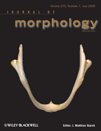A novel membrane specialization in the sperm tail of bug insects (heteroptera)†
The paper is dedicated to the memory of our unforgettable friend Bjorn A. Afzelius, recently passed away.
Abstract
The sperm tail of bug insects has 9 + 9 + 2 flagellar axonemes and two mitochondrial derivatives showing two to three crystalline inclusions in their matrix. During spermiogenesis, the axoneme is surrounded by a membrane cistern which, at sperm maturity, reduces to two short cisterns on the opposite sides of the axoneme adhering to the mitochondrial derivatives. Filamentous bridges connect the intertubular material of the axoneme to these cisterns. Such bridges, which represent a peculiar feature of bug insects, are resistant to detergent treatment, whereas part of the intertubular material and the inner content of microtubular doublets are affected by the treatment. After freeze-fracture replicas, at the insertion of the bridges to the cisternal membrane, the P-face of this membrane shows a characteristic ribbon consisting of four rows of 11 ± 1 nm staggered intramembrane particles, 13 ± 2 nm apart along each row. The bridges could be able to maintain the axoneme in the proper position during flagellar beating avoiding distortion affecting sperm motility. J. Morphol. 2009. © 2009 Wiley-Liss, Inc.




